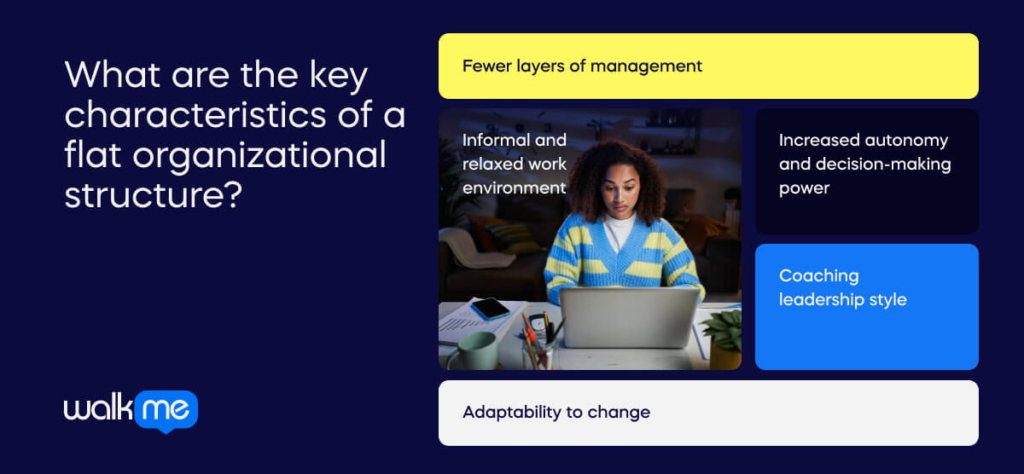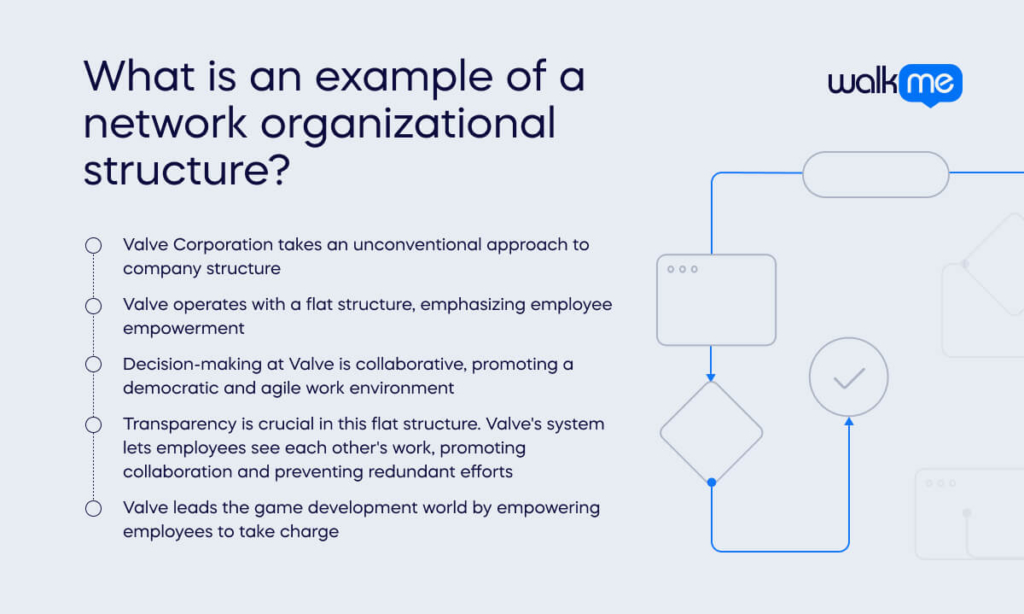Modern business increasingly depends on adaptability and innovation, prompting many organizations to adopt new structures that reduce bureaucracy and shift away from top-down decision-making. The right structure can influence everything from operational efficiency to internal communication.
Flat organizational structures stand out by minimizing hierarchy and giving managers greater autonomy. This not only helps organizations meet customer demands but also makes it easier to respond to shifts in the business environment—an area where effective change management is essential.
In this article, we’ll explore the key characteristics of a flat organizational structure. We’ll compare it to a traditional hierarchical model, provide a visual example, and share practical tips for implementing a flat structure successfully.
What is a flat organizational structure?
In a flat organizational structure, there are minimal levels of hierarchy between employees and leadership. All employees generally have equal levels of authority. In a conventional hierarchical arrangement, employees report to first-line managers.
These managers then report to middle managers. The middle managers relay information to the senior managers at the hierarchy’s apex.
In a flat organization, the structure differs.
By reducing hierarchical levels, associates can communicate with higher-level managers. This eliminates the need for middle managers. The distribution of responsibilities between associates and higher-level managers decentralizes authority.
The lack of middle layers fosters accountability. It also enables employees to communicate directly with leadership.
What are the key characteristics of a flat organizational structure?

Here are the vital features of a flat organizational structure you need to know:
Fewer layers of management
A flat organizational structure has minimal levels of management between employees and executives. In certain instances, there might only be a single layer of leadership between workers and the C-Suite. Employees can communicate with top leaders, bypassing middle managers.
Informal and relaxed work environment
Informal and relaxed work environments are common in organizations with a flat structure. Staff proximity to top management and a decreased focus on formal titles foster a more accessible and flexible environment.
Increased autonomy and decision-making power
Employees in flat organizations have more autonomy and decision-making power. This setup is ideal for individuals focusing on direct answers and transparent procedures. You can also encourage sharing ideas. Creating an employee feedback loop within the company is also crucial. This develops a culture of collaboration and teamwork.
Coaching leadership style
In flat organizations, leaders prefer a coaching plan approach over an authoritative one. This approach supports the focus on empowering and involving employees. It enables them to take ownership of their work and contribute to the organization’s success.
Adaptability to change
Flat organizations tend to be more adaptable to changes. The lack of many hierarchical levels allows them to adapt to shifts in the market or environment.
A flat organizational structure removes the layers of bureaucracy found in traditional organizations. This efficient approach improves productivity and empowers employees, making them essential to the company’s achievements.
What is the difference between flat and tall/hierarchical organizational structures?
The structure of a company either follows a tall (vertical) or a flat (horizontal) one.
In an organizational chart, tall structures contain the CEO at the top and many levels of management below.
This establishes a clear hierarchy for reporting and decision-making. In comparison, flat organizational structures have fewer management levels. This gives employees more freedom and promotes a collaborative and empowered workplace.
Here are the main differences between the two types:
| Flat | Tall/Hierarchial | |
| Management Levels | Little or no layers of management with shared decision-making and equality | Multiple layers of management with a clear head of command. |
| Communication and decision-making | Faster communication and decisions due to fewer management layers. | Slower communication and decision-making are due to the need for various approvals. |
| Ideal industry use | Creative businesses, small businesses, NGOs, or startups. | Multinational companies, government corporations, or large businesses. |
| Autonomy of employees | More autonomy due to a flatter structure and shared responsibility | Less autonomy due to several management layers. |
| Flexibility | Can adapt to market changes easily due to streamlined structure. | Less adaptable to change due to rigid structure |
What is an example of a flat organizational structure?

Valve Corporation, the renowned video game developer behind Half-Life and Dota 2, takes an unconventional approach to company structure.
Unlike many organizations with established managerial hierarchies, Valve operates with a flat structure, emphasizing employee empowerment. This means employees are not simply assigned tasks; they can choose projects that align with their interests and expertise.
Think of a programmer with a deep passion for artificial intelligence, gravitating toward a cutting-edge AI initiative. Or a level designer collaborating with artists to craft a visually stunning environment.
Decision-making at Valve is collaborative, promoting a democratic and agile work environment. Programmers, designers, and writers can brainstorm a new game concept, where each voice contributes to the final vision.
Transparency is critical within this flat structure. Valve leverages a unique system that allows employees to see what everyone else is working on, promoting collaboration and eliminating redundant efforts.
While this approach has challenges, it champions innovation and creativity – essential qualities in the fast-paced gaming industry.
Valve positions itself at the forefront of the game development world by empowering employees to take charge.
Best practice for implementing a flat organizational structure

Here’s how you put in place a flat organizational structure at your business:
Assess the need for a flat organizational structure
When considering if a flat organizational structure is right for your business, check its necessity and possible advantages. Certain companies excel with less hierarchy, while others may need a traditional approach.
Check your organizational culture, goals, and operational requirements to determine the optimal organizational structure. Explore the possibility of blending different organizational approaches. For example, you can restructure some teams while preserving hierarchy in others.
Clarity of roles and responsibilities
A flat organizational structure requires a strong emphasis on defining roles and responsibilities. With a leaner management structure, each employee needs to understand their position in the team. They should also understand their wider role in the organization.
Smooth operations rely on defining job roles. It should also focus on outlining reporting relationships and establishing expectations for collaboration. Offer collaborative training and resources to empower employees to fulfill their duties.
Establishing clear policies and procedures
Clear policies and procedures are crucial for empowering employees in a flat organization. Establish a framework for success by defining guidelines for decision-making, communication channels, and conflict resolution.
Implement an open-door policy to encourage transparency and accessibility. This policy can allow employees to voice concerns, share ideas, and seek guidance from executives. Cultivating an atmosphere of openness and collaboration fosters employee appreciation and support in their roles.
Employee recognition and development
In a flat structure, traditional avenues for promotion are less. So, it’s essential to recognize and reward exemplary performance. Create a strong employee recognition program that rewards achievements and reinforces positive behaviors.
Provide chances for professional growth and progress through training, mentoring, and cross-functional projects. When you invest in their continual development, you show dedication to helping your employees thrive. It can also encourage them to make valuable contributions to the organization’s success.
Addressing leadership consent and trust
It’s important to get approval from key executives. Ensure they grasp the implications of the shift before moving towards a flat organizational structure.
Foster open dialogue with executives to address their concerns. Establish clear expectations for employee autonomy and decision-making authority. Foster a culture of trust and empowerment. This ne where servant leaders trust their employees to work and make wise decisions.
Managing internal conflicts
Conflicts are unavoidable in every organization. This is especially true in a flat structure without a formal hierarchy. Deal with conflicts and power struggles to prevent disruption in productivity.
Offer conflict resolution training to help employees handle difficult situations. Encourage open communication and mediation to foster resolution. Maintain a respectful, harmonious workplace where you can value everyone’s voice.
Promoting effective collaboration
The success of a flat organizational structure relies on effective collaboration. Encourage collaboration and knowledge sharing. This will help you tap into your team’s diverse talents and expertise.
Use collaboration tools and technologies for effective communication. These tools can also assist with efficient project management and team visibility. Cultivate a culture that appreciates and honors collaboration.
This approach recognizes that combined successes emerge from working as a team. You can cultivate an environment that empowers employees to excel in the organization. They can also propel the organization forward.
Key takeaways for a flat organizational structure
The flat organizational structure reduces hierarchy and decentralizes decision-making, eliminating middle management. A hierarchical structure resembles a pyramid with a vertical chain of command. But, in a flat organizational structure, there are minimal or no middle managers. The C-suite is accessible to all employees.
Key features involve reduced levels of hierarchy. This results in supervisors overseeing many employees with wide spans of control. It also includes decentralized decision-making that empowers employees with more autonomy. Implementing this structure encourages open communication between executives and employees. It minimizes bureaucracy and red tape, improving efficiency.
Startups and small businesses prefer flat structures due to their agility and adaptability. However, larger organizations also adopt them to enhance innovation, collaboration, and employee engagement. A flat structure offers faster decision-making, increased creativity, and innovation. It also allows improved communication, a better employee experience, and reduced overhead costs.
Yet, you need to address limitations. These include role confusion, reduced accountability, limited career progression, and potential supervisor burnout. Companies should check needs, define roles, and encourage autonomy. You should do this to put this structure in place. They also need to offer development opportunities to create a flat organizational structure. Businesses can improve workplace effectiveness by adopting these practices to empower employees.

Common Questions
Flat structures enhance agility and cross-functional collaboration, enabling faster decision-making and adaptability—key factors for successful digital transformation.
With fewer hierarchical levels, flat organizations offer limited traditional promotion paths, potentially leading to employee dissatisfaction regarding career advancement opportunities.
Enterprises should consider adopting a flat structure when seeking to foster innovation, improve communication, and increase responsiveness to market changes, especially in dynamic industries.
Implementing clear role definitions, establishing decision-making guidelines, and promoting open communication can mitigate role ambiguity in flat organizations.
Leaders should shift from authoritative roles to coaching and mentoring, empowering employees, facilitating collaboration, and fostering a culture of shared responsibility.

